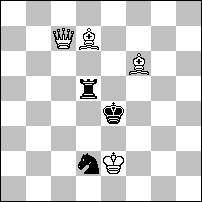
Reciprocal Correction with Black Rook
in Twomover Miniatures
by Robert Lincoln
These examples have reciprocal correction where Black’s rook
is the star performer.
N1 R.Lincoln
"Fun with Chess Miniatures" 1996

#2
The mechanism of
No.1 is well-known, but that Black knight may provide a fair chance
for originality. 1.Qc3!
(2.Qe3) provokes 1…R-file/Re5
2.Q(x)e5# and 1…R-rank/Rd4
2.Q(x)d4#. The other defender
contributes 1…Sc4 2.Qf3#.
N2 R.Lincoln
"Fun with Chess Miniatures" 1996
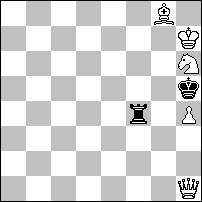
#2
Some useful
changed play occurs in No.2.
1.Be6? (zz) garners 1…R-file/Rg4 2.B(x)g4# and 1…Rxh4
2.Qd5#, but 1…Rf5! Actually,
1.Qh3! (zz) substitutes 1…R-file/Rg4 2.Q(x)g4# and 1…Rxh4
2.Qf5#. The remaining
1…R-rank/Rf7+ falls to 2.B(x)g6#.
N3 R.Lincoln
"More Fun with Chess Miniatures" 2000
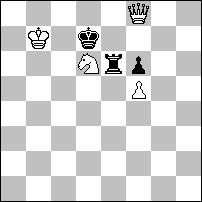
#2
Obviously, White’s knight must start for No.3.
However, the logical 1.Sf7? (2.Qd8#) gets denied 1…Rb6+!
More exact is 1.Sc8! (zz) which promptly dispatches 1…R-rank/Re7
2.Qxe7# and 1…R-file/Rb6+
2.S(x)b6#. One last desperate 1…Re8
brings 2.Qd6#.
N4 R.Lincoln
"Кудесник" 2001
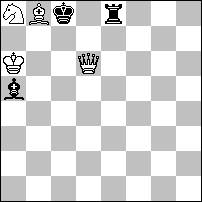
#2
Two nice
peripheral offshoots are drawn from No.4.
1.Bc7! (zz) organizes the expected 1…R-file/Rd8
2.Q(x)d8# and 1…R-rank/Re6
2.Q(x)e6#. Bonus frills are
1…B~ 2.S(x)b6# and 1…Bxc7
2.Qxc7#.
N5 R.Lincoln
"Рыбинск-7 дней" 2005
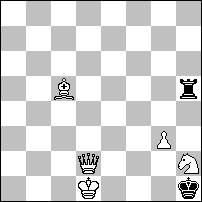
#2
N6 R.Lincoln
"The Problemist" 2006
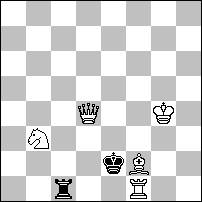
#2
There are
abundant tries and virtual activity in the beguiling No.6.
A waiting gesture like 1.Kf4? (zz) gives 1…Re1
2.Rxe1#, but 1…Kxf1! 1.Kg3? (zz)
advances with 1…Kxf1 2.Qd3#, but
1…Rc3+! 1.Sd2? (2.Qe3#) transfers
2.Re1# for 1…Rc3, but 1…Rxf1! 1.Rd1?
(2.Qd2, Sxc1#) gets refuted 1…Rxd1!
1.Rg1? (2.Qd2, Qe3, Sxc1#) is no better due to 1…Rxg1+!
The solution turns on 1.Bg1! (zz).
The customary formula follows after 1…R-rank/Rc4
2.Q(x)c4# or 1…R-file/Rd1
2.Q(x)d1#. Then comes the best part.
Three “elimination” tactics attend 1…Re1
2.Rf2#, 1…Rxf1 2.Qd2#, and
1…Kxf1 2.Qf2#.
Altogether there are nine assorted mates.
N7 R.Lincoln
Original
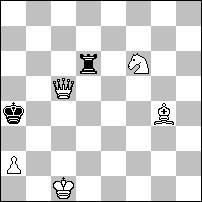
#2
No.7 has
the Black King’s sole guardian placed at an outlying position.
The reckless 1.Qc4+? catches 1…Ka3
2.Qb3#, but 1…Ka5! 1.Bd7+?
destroys 1…Rc6 2.Bxc6#, but 1…Rxd7!
1.Sd5? (2.Qb4, Sc3, Bd1#) is also captured 1…Rxd5!
A more discreet 1.Se4? (2.Sc3#) is met
1…Rd3! Ultimately, 1.Sd7!
(zz) does the trick. Now the
besieged castle must glumly surrender to 1…R-rank/Rd1+
2.B(x)d1#, 1…R-file/Rb6
2.S(x)b6#, and 1…Rxd7 2.Bxd7#.
N8 R.Lincoln
Original
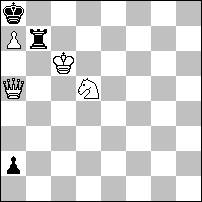
#2
Everything seems to be already set for No.8.
2.Qd8# pounces in the event of 1…Rxa7.
Nonetheless, something must be done about 1…a1Q!
1.Qxa2? proves no help because 1…Rxa7!
becomes playable. So,
1.Qa6! (2.Qxb7#) applies a critical threat which alters 1…Rxa7 to 2.Qc8#.
The rest is apparent:
1…R-rank/Rb6+ 2.S(x)b6# and
1…R-file/Rc7+ 2.S(x)c7#.
N9 R.Lincoln
Original
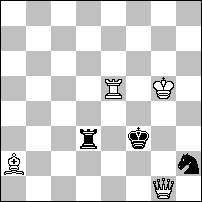
#2
One optimistic try accompanies No.9.
1.Bf7? zooms off hoping for 1…Sf1
2.Bh5#, but 1…Sg4! Of course,
the patient 1.Be6! (zz) adroitly settles the issue.
Results are 1…R-rank/Rd5
2.B(x)d5#, 1…R-file/Re3 2.R(x)e3#,
and 1…S~ 2.B(x)g4#.
N10 R.Lincoln
Original
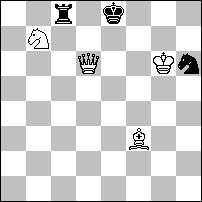
#2
Another errant bishop try is featured in No.10.
1.Bh5? (2.Kxh6#) is obstructed by 1…Sf7!
Once again, a meticulous waiter carries the day.
1.Bd5! (zz) calmly anticipates 1…R-rank/Rc6
2.B(x)c6#, 1…R-file/Rd8
2.Q(x)d8#, and 1…S~ 2.B(x)f7#.
N11 R.Lincoln
Original
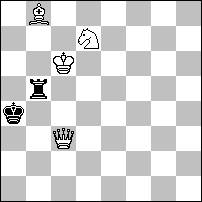
Two
passable tries augment No.11.
1.Qc4+? fetches 1…Rb4 2.Qa2# or
1…Ka5 2.Qxb5#, but 1…Ka3!
1.Bd6? (2.Qa3#) produces 1…Rb4
2.Qxb4#, but 1…Rb3! holds. As
usual, the quiet pause 1.Bc7! (zz) scores.
Derivatives are 1…R-rank/Rb6+
2.S(x)b6#, 1…R-file/Rc5+ 2.S(x)c5#,
and 1…Rb3 2.Qa5#.
N12 R.Lincoln
Original
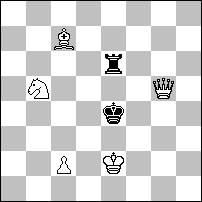
#2
In
No.12, 1…Rd6! is a constant nemesis that copes with 1.Qc5? (2.Sc3#),
1.Qh5? (2.Qf3#), or 1.c4? (2.Qd5, Qg4, Qf4#).
The innocent 1.c3! (zz)
puts the boot to 1…R-rank/Re5
2.Q(x)e5# and 1…R-file/Rd6
2.S(x)d6#.
Robert Lincoln
1.10.2012